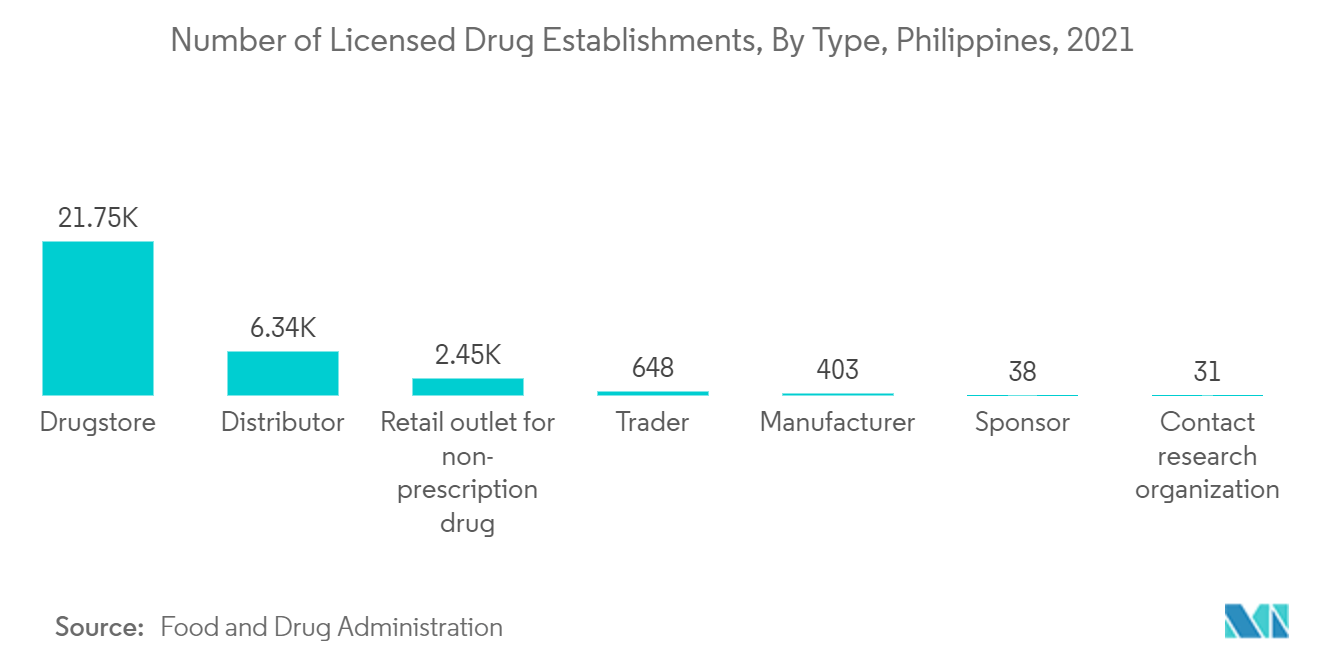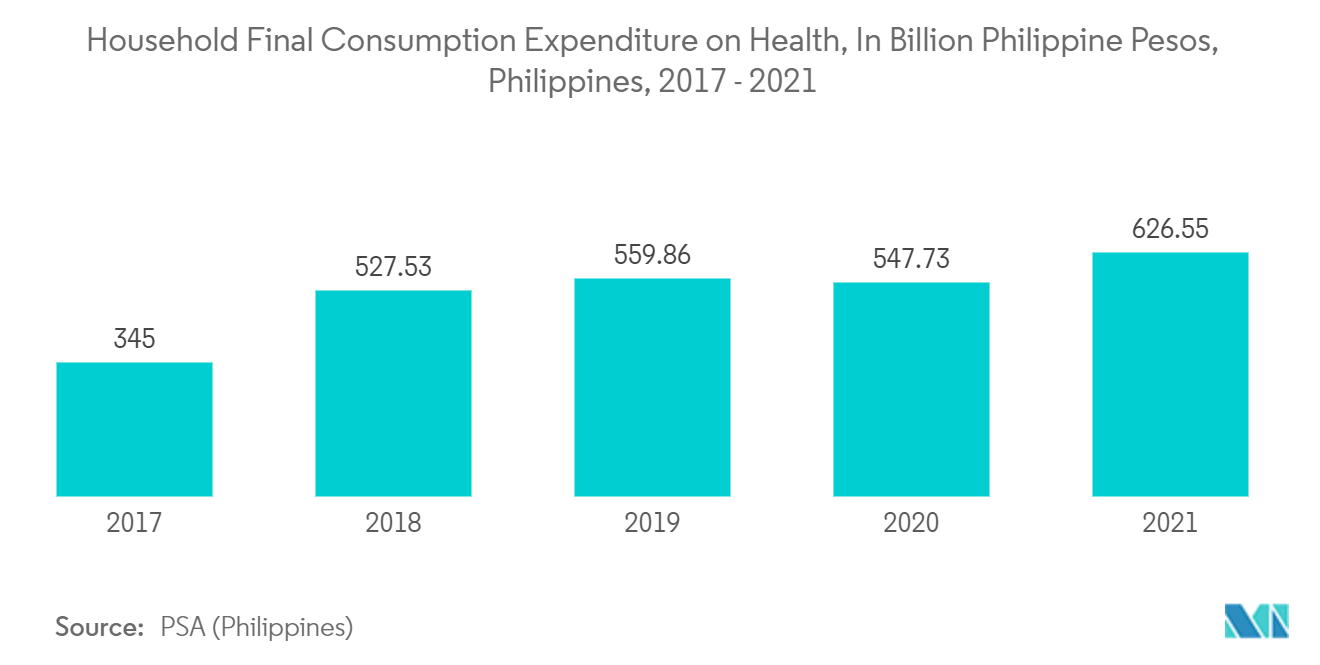Market Trends of Philippines Pharmaceutical Packaging Industry
This section covers the major market trends shaping the Philippines Pharmaceutical Packaging Market according to our research experts:
Surge in Demand for Medicines and Stringent Norms Against Counterfeit Products are Expected to Drive the Market Growth
- Organized pharmacy retail chains are growing aggressively in the Philippines. In order to achieve speedy growth, the pharmacy chains are acquiring independent pharmacies and regional chains as it helps them to save the costs and operations to open a pharmacy store and build it up from scratch. Manila, Central Luzon, and Bicol Region have been key target regions for opening new pharmacies. As the market is becoming concentrated day by day, the companies are focusing on opening stores in different provinces and less developed regions of the country, especially in the Visayas Islands.
- In the Philippines, pharmaceutical drugs are regulated into three segments, namely, originator, branded generics, and unbranded generics. Due to its low manufacturing costs and high sales over the years, many pharmaceutical corporations opted for producing more branded and unbranded generics.
- According to DOH (Philippines), in the Philippines, several diseases are prevalent throughout the country. The number of deaths due to acute upper respiratory disease among Filipinos amounted to millions in 2019 and 2020. The other leading diseases affecting communities are hypertension, urinary tract infection, acute lower respiratory tract infection and pneumonia, skin disease, animal bites, bronchitis, and influenza. This is leading to a major surge in demand for drugs, leading to growth in the packaging market.
- The shift has been made from infectious disease to non-communicable disease, with diet, alcohol, and low exercise causing heart disease and other conditions to grow rapidly. Healthcare products and medicines are in demand in the Philippines. According to the Philippine Statistics Authority (PSA), the country's current health expenditure (CHE) has grown by 10.9% in 2019-2020, reaching a total amount of approximately PHP 792 billion (USD 16.5 billion).
- There is a high acceleration rate due to numerous government reforms and the introduction of a Universal Health Coverage (UHC) scheme, which provides the basic level of healthcare to all Filipinos. There are also new laws mandating public hospitals to provide generic drugs so as to give affordable medicine to Filipinos. At present, 14 of the world's top 20 pharmaceutical companies own a manufacturing base in the Philippines. With government efforts to ease the business registration process in the country, business opportunities in the industry have grown and expanded over the years.
- As per DOH (Philippines) and Food & Drug Administration, In 2021, there were around 31.65 thousand licensed drug establishments in the Philippines, nearly 22 thousand of which were drugstores. Among the leading drugstores in the country were The Generics Pharmacy and Mercury Drug. On the other hand, there were over six thousand drug distributors in the country.

Increasing Health Issues Among the Citizens is Expected to Drive the Market Growth
- In the Philippines, 78% of the population has insurance coverage, and branded drugs dominate the market. The Philippines was the 11th most attractive market globally for pharmaceutical companies and the 3rd most attractive among the ASEAN countries. This is majorly due to various factors such as the growing population, high rate of medical tourism, and other similar factors (source: Pharmaceutical & Healthcare Association of the Philippines (PHAP)).
- The rapid increase in income among Filipinos and the medical industry's heavy reliance on imports create a demand within the country that foreign firms can take advantage of. The industry expert studies show that cardiovascular diseases, such as heart failure, heart attacks, and cancer, are the two leading causes of death in the Philippines. To ensure the efficacy of anticancer drugs, which are heat-sensitive, it is essential to opt for insulated packaging solutions as secondary packaging and container as primary packaging.
- In the Philippines, diabetes is rapidly becoming a major public health issue, as in other low- and middle-income countries. Availability and affordability of care and medicines are crucial to controlling diabetes. In the Philippines, 1 in 14 Filipino adults lives with diabetes. As of 2019, International Diabetes Federation (IDF) data showed that 3,993,300 of the then total 63,265,700 Filipino adult population had diabetes, with a 6.3% prevalence of diabetes in adults. In the coming time, it is expected that the number of diabetic patients will increase in the country, which is expected to cater to a major demand for insulin, leading to major demand for container packaging.
- Moreover, according to PSA (Philippines), household spending on health has gradually increased over the past five years and was highest in 2021 after the COVID-19 pandemic outbreak. In 2021, the household final consumption expenditure for health in the Philippines was valued at approximately 627 billion Philippine pesos.
- There is significant pressure on the government and the healthcare sector to revolutionize the state of Philippine healthcare. Demand is primarily driven by a growing and aging population. According to United Nations, in 2015, the share of the population older than 65 amounted to about 4.6 percent. In 2100, the population above 65 was forecasted to reach 25.6 percent. The share of the aging population was forecasted to increase throughout the years. This factor would lead to major generic medicine demand in the country, catering to the major packaging needs such as bottles & containers, syringes & cartridges, vials & ampoules, and pouches & packs. Glucose drip is expected to cater to a major demand due to the aging population. This would lead to demand for pouch packaging, which is needed for glucose packaging.
- According to Trend Economy, India had a major import share of pharmaceutical products in the Philippines, with around 15.7% in 2020, Germany with 13.4%, and the United States with 11.5%. In the context of export to the Philippines, the major share was of Singapore (21%), Thailand (14.8%), and Japan (12.5%). It is expected that the same trend for import-export for these countries will continue in the future. This would lead to major demand for pharma packaging. Further, according to Philippine Pharmaceutical Manufacturers Association (PPMA), the industry's growth in the next five years will be supported by the implementation of the universal health care program. The Universal Health Care program by the government will give local manufacturers and foreign traders opportunities to participate in the supply of pharmaceutical products through government bids.


